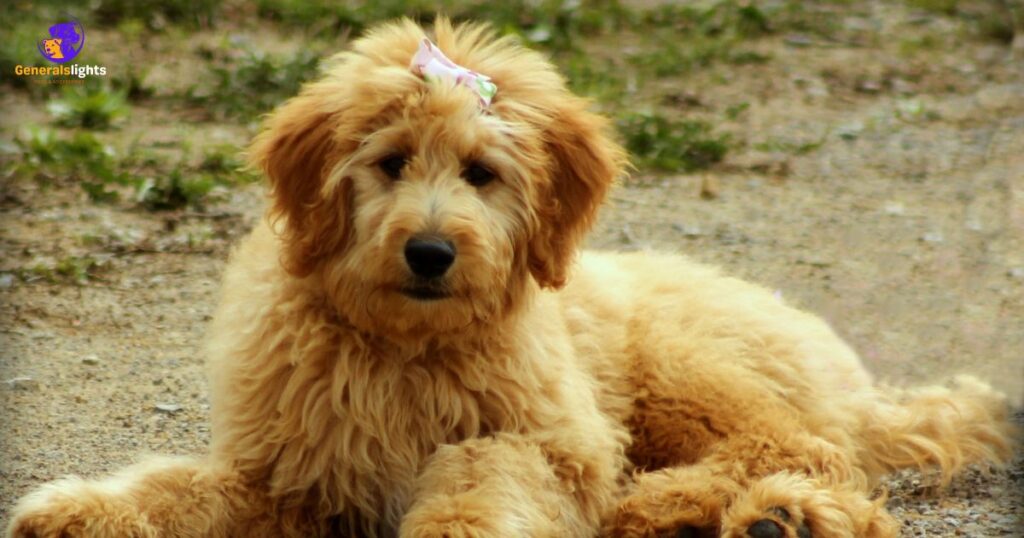The Golden Irish is a hybrid breed, combining the Golden Retriever and the Irish Setter. These dogs are known for their friendly nature and striking appearance.
Are you looking for a loyal and energetic companion? The Golden Irish might be the perfect fit for you! With their beautiful coats and playful demeanor, they bring joy to any home. Discover why this hybrid breed is gaining popularity among dog lovers!
The Golden Irish thrives on companionship and loves to be active. This breed requires regular exercise to stay healthy and happy. Training your Golden Irish is essential, as they are intelligent and eager to please. With proper care, your Golden Irish will become a cherished member of your family.
Golden Irish breed overview
The Golden Irish is a delightful hybrid breed that blends the friendly nature of the Golden Retriever with the spirited personality of the Irish Setter. Known for their striking appearance, Golden Irish dogs often sport a beautiful, wavy coat that can vary in color from golden to rich chestnut. This breed is not only charming but also highly energetic, requiring regular exercise and mental stimulation to thrive.

Caring for a Golden Irish involves understanding their needs and providing consistent training. These dogs are social and thrive on companionship, making them excellent family pets. With a loving and active environment, a Golden Irish can develop into a loyal and well-behaved companion. Their friendly demeanor and intelligence make them a joy to train and an ideal addition to any household.
| Characteristic | Description |
| Breed Type | Hybrid (Golden Retriever and Irish Setter) |
| Size | Medium to large |
| Coat Type | Wavy and water-resistant |
| Shedding Level | Moderate |
| Temperament | Friendly, energetic, and social |
| Exercise Needs | High; daily walks and playtime are essential |
| Lifespan | 10-14 years |
| Grooming Requirements | Regular brushing; bathing as needed |
The Golden Irish is a wonderful blend of two beloved breeds, making them a popular choice for active families.
Golden Irish Health
The Golden Irish generally enjoys good health, but like all breeds, they can be prone to specific health issues. Regular vet check-ups and a balanced diet play essential roles in maintaining their well-being. Staying active and mentally stimulated also contributes to their overall health.
- “Golden Irish are prone to hip dysplasia.”
- “Regular exercise helps maintain a healthy weight.”
- “Dental health is crucial for the Golden Irish.”
- “Watch for skin allergies common in the breed.”
- “Early vet visits can catch issues early.”
Golden Irish Breed History
The Golden Irish originated as a hybrid breed, mixing the Golden Retriever with the Irish Setter. Breeders aimed to combine the best traits of both parent breeds, resulting in a dog that is friendly and energetic. Over the years, this breed has gained popularity for its loyal and loving nature, making it a sought-after family companion.
As a relatively new breed, the Golden Irish benefits from the rich histories of its parent breeds. The Golden Retriever was developed in the 19th century for retrieving game, while the Irish Setter has roots in hunting and retrieving in Ireland. Together, they create a versatile dog that excels in various roles, from family pet to working companion.
Today, the Golden Irish is cherished for its playful spirit and affectionate demeanor. Owners appreciate their friendly nature and intelligence, making them easy to train. This hybrid breed thrives in active households and forms strong bonds with their families.
Golden Irish Breed Appearance
The Golden Irish boasts a striking appearance that reflects its lineage. This breed typically has a wavy or curly coat, often in shades of gold and chestnut. Their expressive eyes and long ears add to their charming look, making them easily recognizable.
Golden Irish dogs have a well-proportioned body, combining the athleticism of the Irish Setter with the sturdiness of the Golden Retriever. They usually stand between 20 to 28 inches tall, with a weight ranging from 60 to 80 pounds. Their strong build supports their energetic lifestyle, allowing them to excel in various activities.
With a friendly and approachable demeanor, the Golden Irish often attracts attention wherever they go. Their playful nature and striking coat make them a favorite among dog lovers. A well-groomed Golden Irish can truly be a showstopper, showcasing the best of both breeds.
| Feature | Description |
| Coat Color | Golden to chestnut shades |
| Coat Length | Wavy and medium length |
| Eye Color | Dark amber or brown |
| Size | Medium to large |
| Weight | 60-80 pounds |
The Golden Irish is not just a beautiful breed; it’s also a delightful companion for active families.
Similar Breeds to the Golden Irish
If you’re considering a dog similar to the Golden Irish, you might want to look at the Golden Retriever. Known for their friendly and gentle nature, Golden Retrievers share many traits with the Golden Irish, including their love for family and playfulness. Both breeds are highly trainable and thrive in active households, making them excellent companions for families.

Another breed to consider is the Irish Setter. This breed is renowned for its energetic personality and striking appearance, much like the Golden Irish. Irish Setters are affectionate and enjoy being part of family activities, ensuring they remain loyal companions. Their intelligence and eagerness to please make them easy to train, just like the Golden Irish.
Similar Breeds
- Golden Retriever: Friendly, loyal, and excellent with families.
- Irish Setter: Energetic, affectionate, and good with kids.
- Labrador Retriever: Playful, social, and easy to train.
- Flat-Coated Retriever: Cheerful, friendly, and great for active families.
- Nova Scotia Duck Tolling Retriever: Intelligent, playful, and energetic.
- English Setter: Gentle, friendly, and suitable for active households.
- Cocker Spaniel: Affectionate, playful, and great for families.
- Weimaraner: Energetic, loyal, and requires regular exercise.
These breeds offer similar traits to the Golden Irish, making them excellent alternatives for those looking for a friendly and active dog.
Golden Irish Breed Maintenance
Maintaining a Golden Irish involves regular grooming and exercise to keep them healthy and happy. You should brush their coat at least once a week to reduce shedding and prevent mats.
Daily exercise is vital, as this breed thrives on activity and mental stimulation. Keeping their environment engaging will help your Golden Irish develop into a well-rounded companion.
| Maintenance Task | Frequency | Purpose | Tools Needed | Impact on Health | Additional Notes |
| Brushing | Weekly | Prevent mats and reduce shedding | Slicker brush, comb | Healthy coat | More often during shedding seasons |
| Bathing | Every 2-3 months | Clean and refresh coat | Dog shampoo | Maintains skin health | Avoid over-bathing |
| Exercise | Daily | Maintain energy and health | Leash, toys | Reduces behavioral issues | Varies with age and health |
| Nail Trimming | Monthly | Prevent discomfort | Dog nail clippers | Protects paws | Watch for quicks |
| Ear Cleaning | Monthly | Prevent infections | Cotton balls, ear cleaner | Maintains ear health | Check for wax buildup |
| Teeth Brushing | 2-3 times a week | Promote dental health | Dog toothbrush, toothpaste | Prevents dental issues | Start young for best results |
| Veterinary Check-ups | Annually | Monitor overall health | N/A | Early detection of issues | Keep vaccinations current |
| Socialization | Ongoing | Develop good behavior | Group classes, playdates | Reduces anxiety | Important for young dogs |
With regular maintenance, your Golden Irish can lead a happy and healthy life.
Golden Irish Health
The Golden Irish generally enjoy good health, but they can be prone to certain genetic conditions. Regular vet visits and a balanced diet are crucial for monitoring their well-being. Staying active helps maintain a healthy weight and reduces the risk of common health issues.

Another important aspect of Golden Irish health is preventative care. Regular grooming helps you spot any skin issues early, while dental hygiene is essential for preventing oral diseases. Awareness of potential health concerns allows you to take proactive measures to ensure your dog remains healthy.
Health Concerns
- Hip Dysplasia: A common genetic condition in the Golden Irish, hip dysplasia occurs when the hip joint doesn’t fit into the hip socket properly.
- Elbow Dysplasia: This condition affects the elbow joint and can lead to arthritis if not managed properly. Regular check-ups can help catch these issues early.
- Ear Infections: The floppy ears of the Golden Irish can trap moisture and debris, making them prone to infections.
Hip Dysplasia and Elbow Dysplasia
Hip dysplasia is a hereditary condition that affects the hip joint’s structure. In a Golden Irish, this may lead to pain, lameness, or difficulty in movement. Regular vet check-ups and maintaining a healthy weight can help manage this condition.
Elbow dysplasia also poses a risk for the Golden Irish, affecting their mobility and overall quality of life. Symptoms can include limping and stiffness, particularly after exercise. Early detection through veterinary care is essential for effective management and treatment.
Both conditions emphasize the need for responsible breeding practices and regular health screenings. By being proactive, you can help ensure your Golden Irish lives a comfortable and active life.
Ear Infections
Ear infections are a common issue in the Golden Irish due to their floppy ears. These ears can trap moisture and dirt, creating an ideal environment for bacteria and yeast to thrive. Regular ear cleaning helps prevent infections and maintains ear health.
Signs of ear infections in a Golden Irish may include scratching at the ears, shaking their head, or a foul odor. If you notice these symptoms, it’s essential to consult your veterinarian. Prompt treatment can prevent further complications and ensure your dog remains comfortable.
Preventative care, including regular ear checks, can significantly reduce the risk of infections. Keeping the ears dry and clean allows your Golden Irish to enjoy a happier, healthier life without discomfort.
Gastric Dilatation-Volvulus (GDV)
Gastric Dilatation-Volvulus (GDV), or bloat, is a serious condition that can affect the Golden Irish. It occurs when the stomach fills with gas and twists on itself, leading to severe complications. Recognizing the signs, such as a swollen abdomen or restlessness, is critical for immediate treatment.
GDV is most common in deep-chested breeds like the Golden Irish. Factors such as rapid eating, stress, or vigorous exercise after meals can contribute to the risk. Preventative measures include feeding smaller meals and avoiding exercise right after eating.
Emergency treatment is necessary to relieve the pressure and stabilize the dog. If left untreated, GDV can be life-threatening, emphasizing the need for awareness among Golden Irish owners. Regular vet check-ups can help monitor your dog’s health and identify risks early.
What to Feed an Irish Setter Golden Retriever Mix
Feeding a Golden Irish requires a balanced diet tailored to their active lifestyle. High-quality dog food that lists real meat as the first ingredient is essential for their energy needs. Look for formulas specifically designed for large breeds to support their growth and joint health.

In addition to commercial dog food, you can incorporate healthy treats and fresh vegetables into their diet. Foods like carrots and green beans can provide extra nutrients without adding unnecessary calories. Always ensure any additions are safe and approved for dogs.
Monitoring your Golden Irish’s weight is crucial, as they can be prone to obesity. Adjust portion sizes based on their activity level and consult your veterinarian for personalized feeding guidelines. Keeping a close eye on their diet helps maintain their health and vitality.
Golden Irish Temperament
The Golden Irish is known for its friendly and affectionate nature. This breed thrives on companionship and loves being around people. Their gentle disposition makes them excellent family pets, particularly with children.
Socialization is essential for a Golden Irish to develop a well-rounded temperament. Early exposure to various environments and people helps prevent shyness or anxiety. A confident Golden Irish tends to be more adaptable and friendly in new situations.
Intelligence is another key trait of the Golden Irish. They are eager to please, making training enjoyable and rewarding. Consistent positive reinforcement will yield the best results when teaching commands or tricks.
Due to their energetic nature, the Golden Irish requires regular mental and physical stimulation. Engaging activities such as fetch, agility training, or obedience classes can help fulfill their needs. A bored Golden Irish may resort to undesirable behaviors, so keeping them busy is vital.
Golden Irish Activity Requirements
The Golden Irish is an active breed that requires ample exercise to stay healthy and happy. Daily walks, playtime, and interactive games are essential to meet their activity needs. Aim for at least 60 to 90 minutes of exercise each day to keep them physically fit.
In addition to regular walks, providing mental stimulation is crucial for a Golden Irish. Puzzle toys, training sessions, and socializing with other dogs can help keep their minds sharp. A well-exercised Golden Irish is less likely to develop behavioral issues.
Golden Irish Owner Experiences
Owners of the Golden Irish often praise their friendly and affectionate nature. Many describe their dogs as loyal companions who thrive on family interaction. This breed’s playful demeanor adds joy to everyday life.
Training experiences with the Golden Irish are generally positive, as they are eager to learn. Consistent training and socialization lead to well-behaved dogs that adapt well to various environments. Many owners appreciate their dog’s intelligence and willingness to please.
- Affectionate and loyal family pets.
- Require regular exercise to stay happy.
- Eager learners, making training enjoyable.
- Adapt well to various living situations.
- Need early socialization to develop confidence.
The Golden Irish truly shines as a loving and energetic companion for families.
FAQs
How big do Golden Irish dogs get?
Golden Irish dogs typically weigh between 60 and 80 pounds. They usually stand about 20 to 28 inches tall at the shoulder.
What is the temperament of a Golden Irish?
The Golden Irish are known for being friendly and affectionate. They thrive on companionship and enjoy being around people.
How much exercise does a Golden Irish need?
A Golden Irish requires 60 to 90 minutes of exercise each day. Daily walks and playtime are essential for their well-being.
Are Golden Irish dogs good with kids?
Yes, the Golden Irish is excellent with children. Their gentle nature makes them ideal family pets.
What should I feed my Golden Irish?
Feed your Golden Irish high-quality dog food with real meat as the first ingredient. Monitor their weight to prevent obesity.
Conclusion
The Golden Irish is a wonderful blend of intelligence, energy, and affection. With proper care, they thrive as loyal family companions and bring joy to any household.
Investing time in their training and exercise needs helps ensure a happy and healthy life for your Golden Irish. With the right approach, you can enjoy a fulfilling relationship with this loving breed.
- Also Read Must:
- Border Collie breed insights: care, personality, and expert health tips
- How Much Does a Catahoula Leopard Dog Cost in 2024?

Emerson is an expert in the world of pets, specializing in understanding diverse breeds, nutrition, and health. His deep knowledge ensures your pets receive the best care, from balanced diets to top-notch health advice, keeping them at their happiest and healthiest.











